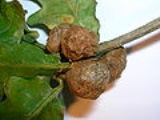
Cola-nut gall
Encyclopedia
Cola-nut galls develop as a chemically induced distortion of leaf axillary or terminal buds on Pedunculate Oak
(Quercus robur) or Sessile Oak
(Quercus petraea) trees, caused by the agamic gall wasp
Andricus lignicola (Hartig, 1840) which lays single eggs within leaf buds using their ovipositor
. A previous name or synonym for the species A. lignicola is A. lignicolus and A. venheurni.

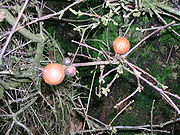 The galls are found in small groups, which however do not coalesce, helping to prevent mis-identification with the Oak marble gall
The galls are found in small groups, which however do not coalesce, helping to prevent mis-identification with the Oak marble gall
(Andricus kollari), in addition the shape is ovoid rather than spherical and it is scaly rather than smooth. It grows up to about 10 x 8 mm and is at first green, rapidly changing to grey-brown, with light red patches where the original bud scales have separated. It is hard and firm, but does not always persist on the tree for very long. Once the imago has emerged a small circular hole is apparent.
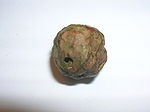 This gall is not thought to be native and was only recorded from 1972. It is well known in continental Europe, occurring from Holland to Asia Minor. The imago of the agamic phase emerges in early summer following the gall's inception. The bisexual generation gall is very similar to that of A. kollari, effecting the live bud of Quercus species and has only been seen under culture conditions (1975).
This gall is not thought to be native and was only recorded from 1972. It is well known in continental Europe, occurring from Holland to Asia Minor. The imago of the agamic phase emerges in early summer following the gall's inception. The bisexual generation gall is very similar to that of A. kollari, effecting the live bud of Quercus species and has only been seen under culture conditions (1975).
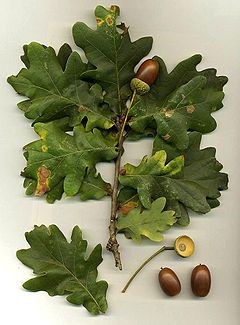
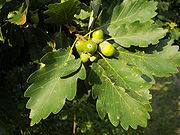 Some herbivorous
Some herbivorous
insects therefore create their own micro-habitats by forming usually highly distinctive plant structures called gall
s, made up of plant tissue but controlled by the insect. Galls act as both the habitat, and food sources for the maker of the gall. The artichoke gall is formed from entirely from the bud
, composed of nutritious starch and other tissues. Some galls act as "physiologic sinks", concentrating resources in the gall from the surrounding plant parts. Galls may also provide the insect with physical protection from predators.
Pedunculate Oak
Quercus robur is commonly known as the Pedunculate Oak or English oak. It is native to most of Europe, and to Anatolia to the Caucasus, and also to parts of North Africa.-Taxonomy:Q...
(Quercus robur) or Sessile Oak
Sessile Oak
Quercus petraea , the Sessile Oak, also known as the Durmast Oak, is a species of oak native to most of Europe, and into Anatolia.-Description:...
(Quercus petraea) trees, caused by the agamic gall wasp
Gall wasp
Gall wasps , also called Gallflies, are a family of the order Hymenoptera and are classified with the Apocrita suborder of wasps in the superfamily Cynipoidea...
Andricus lignicola (Hartig, 1840) which lays single eggs within leaf buds using their ovipositor
Ovipositor
The ovipositor is an organ used by some animals for oviposition, i.e., the laying of eggs. It consists of a maximum of three pairs of appendages formed to transmit the egg, to prepare a place for it, and to place it properly...
. A previous name or synonym for the species A. lignicola is A. lignicolus and A. venheurni.
The physical appearance of the galls


Oak marble gall
Oak marble galls develop as a chemically induced distortion of leaf buds on pedunculate oak , or sessile oak trees, caused by the parthenogenetic gall wasp which lays eggs within leaf buds using their ovipositor...
(Andricus kollari), in addition the shape is ovoid rather than spherical and it is scaly rather than smooth. It grows up to about 10 x 8 mm and is at first green, rapidly changing to grey-brown, with light red patches where the original bud scales have separated. It is hard and firm, but does not always persist on the tree for very long. Once the imago has emerged a small circular hole is apparent.
Life-cycle

Gall-forming insects


Herbivore
Herbivores are organisms that are anatomically and physiologically adapted to eat plant-based foods. Herbivory is a form of consumption in which an organism principally eats autotrophs such as plants, algae and photosynthesizing bacteria. More generally, organisms that feed on autotrophs in...
insects therefore create their own micro-habitats by forming usually highly distinctive plant structures called gall
Gall
Galls or cecidia are outgrowths on the surface of lifeforms caused by invasion by other lifeforms, such as parasites or bacterial infection. Plant galls are abnormal outgrowths of plant tissues and can be caused by various parasites, from fungi and bacteria, to insects and mites...
s, made up of plant tissue but controlled by the insect. Galls act as both the habitat, and food sources for the maker of the gall. The artichoke gall is formed from entirely from the bud
Bud
In botany, a bud is an undeveloped or embryonic shoot and normally occurs in the axil of a leaf or at the tip of the stem. Once formed, a bud may remain for some time in a dormant condition, or it may form a shoot immediately. Buds may be specialized to develop flowers or short shoots, or may have...
, composed of nutritious starch and other tissues. Some galls act as "physiologic sinks", concentrating resources in the gall from the surrounding plant parts. Galls may also provide the insect with physical protection from predators.
Predators, inquilines and parasitoids
None seem to have been recorded in Britain as yet, supporting the recent spread theory of this gall to the United Kingdom.Infestations of cola-nut galls
Removing and destroying cola-nut galls before they dry and the wasps emerge may help to reduce the infestation. While fairly large, and sometimes present in quite large numbers on scrub specimens, they cause no measurable harm.See also
- Knopper gallKnopper gallAndricus quercuscalicis is a gall wasp species inducing Knopper galls.Knopper galls develop as a chemically induced distortion of growing acorns on Pedunculate Oak trees, caused by gall wasps, which lay eggs in buds with their ovipositor...
- Oak marble gallOak marble gallOak marble galls develop as a chemically induced distortion of leaf buds on pedunculate oak , or sessile oak trees, caused by the parthenogenetic gall wasp which lays eggs within leaf buds using their ovipositor...
- oak appleOak appleOak apple is the common name for a large, round, vaguely apple-like gall commonly found on many species of oak. Oak apples range in size from 2-5cm. Oak apples are caused by chemicals injected by the larva of certain kinds of gall wasp in the family Cynipidae. The adult female wasp lays single...
- Rose bedeguar gallRose bedeguar gallThe Rose bedeguar gall, Robin's pincushion gall, or Moss galldevelops as a chemically induced distortion of an unopened leaf axillary or terminal buds mostly on Field Rose or Dog rose shrubs, caused by the parthenogenetic hymenopteran gall wasp , previous synonyms are D...
- gallGallGalls or cecidia are outgrowths on the surface of lifeforms caused by invasion by other lifeforms, such as parasites or bacterial infection. Plant galls are abnormal outgrowths of plant tissues and can be caused by various parasites, from fungi and bacteria, to insects and mites...
- Gall waspGall waspGall wasps , also called Gallflies, are a family of the order Hymenoptera and are classified with the Apocrita suborder of wasps in the superfamily Cynipoidea...
- Pineapple gall
- Red-pea gallRed-pea gallThe Red-pea gall or Red Currant gall develops as a chemically induced distortion arising from the underside of the mid-rib of a vein on Quercus species and it is attached by a short stalk or peduncle...

